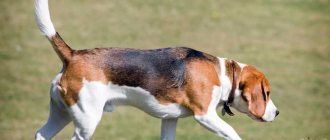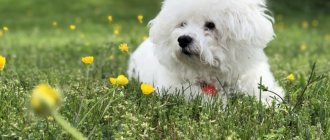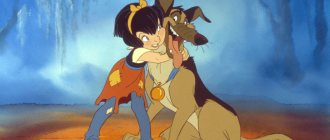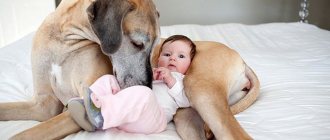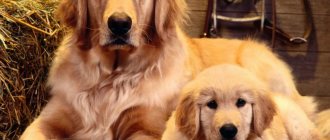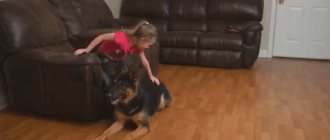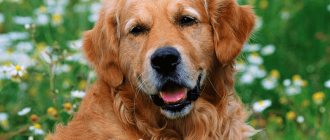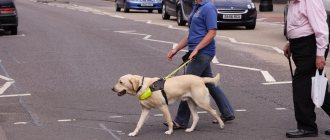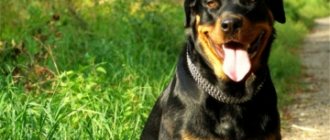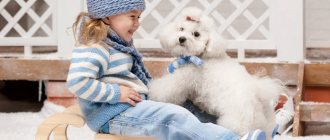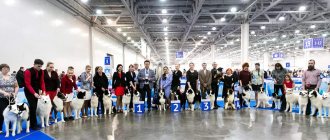History of the breed
Retrievers are a type of hunting dog, the name of the group comes from the English word “retrieve”, which literally translates to “get” or “find”. The main task of such animals is to find and bring the shot prey to the hunter intact. That is why dogs of this group have a developed sense of smell, an obedient character and a soft jaw.
It is believed that retrievers as a breed group formed in England in the 19th century. They were actively used in hunting in conjunction with pointers (pointers and setters). The job of the pointing dog is to find game and lift it to the owner's gun, while the retriever's job is to locate it in the water or tall grass and then bring it to the hunter.
Today, interest in hunting has decreased, so retrievers are more often taken into the role of companions; in some countries they are used for service purposes and raised as a guide dog. Thanks to their developed intelligence, gentle nature and focus on people, they have become one of the most popular pets.
Principles of nutrition
To maintain the beauty of the exterior and health, the Golden Retriever's diet should be varied: in addition to meat and ready-made food (only good quality), it is necessary to include plant foods (vegetables, fruits, dried fruits, a variety of cereals), dairy products and mineral mixtures.
For meat, preference is given to offal (heart, kidneys, tendons, liver, etc.). Meat should be given in the evening feeding, and milk mixtures and vegetables in the morning. Fish (mostly sea) is also included in the diet, but only after heat treatment (like meat) and removal of large bones and sharp fins.
Bones (except tubular ones) with remnants of cartilage and meat are an important element of a hunting dog’s nutrition, as they contain calcium, proteins and gluten, which are necessary for the growth and development of the dog, strengthening the teeth and gums.
During the period of growth of the dog’s body, for the normal formation of bones, joints, muscles and ligaments, it is recommended to give fish oil capsules along with food.
There should always be a drinking bowl next to the food bowl. The water should be boiled and cool, it should be changed 2 times a day. If milk is given to a dog as a drink, then it is diluted with water in the following proportion: 2 measures of milk to 3 measures of water.
Bowls for food and drinking water must be stable and massive, without external defects (chips, nicks, cracks) so that the dog does not injure his tongue.
The Golden Golden Retriever is a dog that brings comfort, joy and a feeling of happiness to the home. This animal will be an ideal leisure companion, an attentive and affectionate nanny for small children and the best friend of the whole family.
Description and characteristics of the breed
Dogs of the retriever breed group were bred specifically to help hunters find shot game, which directly affected their appearance and temperament. All retrievers have a water-repellent coat and well-developed muscles. Thanks to this, they can work in water, thorny thickets and tall grass. Withstands serious physical exertion, long swimming and running in forest areas.
The excellent sense of smell, lack of aggression, and developed intelligence of retrievers have found their application in other areas. They are often trained for service and guide roles. Dogs of this group cope well with many complex tasks:
- search for drugs and explosives;
- accompanying people with disabilities;
- work in hospitals, hospices and psychological centers;
- rescue work in disasters.
All retrievers have an obedient character and are owner-oriented. They do not have a tendency to show aggression towards people or other animals. Despite their innate energy, they adapt well to the role of a pet in city life. Retrievers are the best choice as a first dog, companion, or family pet.
Scope of application
The owner chooses his dog’s profession himself, but in any case it is worth considering the pros and cons of the breed, as well as the characteristics of the pet.
A dog can become an athlete in different types of competitions. Agility parkour is gaining popularity in Russia and the UK. All-around is also suitable.
Rescuers speak very highly of the dogs - their size is suitable for searching for people on flat surfaces, underground and at night. They are indispensable for the work of intelligence services. The dog's affinity for people has made him an excellent guide and assistant for those suffering from musculoskeletal disorders.
The description of the breed is given in general terms. Every dog has its pros and cons, but you can always find an individual approach to this kind creature.
We recommend this article:
How long do Labradors live at home?
Breed standard
Today, according to the FCI and ICF classification, retrievers belong to group 8, which includes 6 main dog breeds. Their features according to the standard:
- well-groomed and smooth coat with a characteristic shine;
- developed muscles, lack of excess weight and minimal amount of subcutaneous fat;
- soft jaw;
- weight and height at the withers depend on the specific breed;
- deep and wide muzzle, pronounced transition from the forehead;
- small ears set at the same level as the eyes;
- the length of the muzzle is equal to the length of the skull;
- proportional and strong body, powerful back;
- black or chocolate nose;
- straight limbs with developed bones.
In addition, at exhibitions, not only the exterior, but also the mental qualities of the dog are assessed. She should not show aggression or fear and allow examination by specialists. Working retrievers undergo special tests depending on the direction of their activity.
Photos of colors
What colors do Labradors have?
The standard recognizes three mono-colors:
- black (resin);
- yellow (fawn, cream);
- brown (chocolate, liver, liver).
NOTE!
For all three colors, one small white spot on the chest is allowed. The pigmentation of the nose, eyelids and lips is only dark. All deviations are considered a defect. True, many shades fall under the designation of yellow and brown color.
Black
Black Labradors are considered a classic of the breed. According to the standard, the black Labrador has pure black fur with a silky sheen, black lips, nose and eyelids.
Chocolate
Chocolate or brown Labradors have the rarest set of genes, which is why chocolate puppies are more expensive than black ones. Acceptable shades are from light to dark brown.
Experts name three main variations:
- standard (light) chocolate;
- liver (liver);
- bitter (dark) chocolate.
The color should be uniform, without overflows, stripes, or transitions. Eyes brown, hazel, nut-yellow, walnut-green. Sometimes chocolate Labradors with blue eyes are born; although such dogs are very beautiful, they are considered a waste and are not allowed for breeding.
Pale yellow
The color palette of fawns is richer than that of black and chocolate, so confusion often occurs. Apricot, peach, blue, and pink colors are also called fawn.
In the first standards, the color was designated as yellow and was considered unacceptable. Only in 1924 this light color of Labradors was recognized and allowed into exhibitions.
According to the FCI, there are three main colors of fawn Labradors:
- cream (light cream, beige, light liver, gray);
- golden (gold, golden, golden);
- red fox (red fox, red fox).
IMPORTANT!
In fawn Labradors, differences in color intensity are allowed. The ears, back and tail may be darker. However, a clearly visible dark mask on the face is considered a fault and leads to culling.
White
There are no white Labradors. This is the name given to either very light fawn or albino dogs. Fawns will have dark noses and lips, while albinos will have pink ones. Albinism indicates a genetic failure; such dogs are not allowed for breeding .
Blue
Blue, silver, champagne Labrador are variants of gray Labrador. Among Labrador lovers who are not interested in participating in shows, these are very fashionable colors. If the shade is too far from fawn-gray, the dog is considered not to meet the standard.
Spotted
The spotted Labrador is not allowed for breeding, but it looks very impressive. Such a dog may fully comply with the standard in appearance, but will cost much less than its counterparts with the correct color.
Dudley
Dudley has a pigmentation problem. They have a pink nose, eyelids, gums, and the edges around the lips. Dudleys are found among Labradors of any color, but most often this defect occurs in golden dogs. It is clear that their breeding is also not encouraged.
What types of retrievers are there - all types
Today there are 6 officially recognized varieties of retrievers. They differ in their history of origin, appearance and temperament. When choosing a specific dog, you should evaluate not only the exterior of the breed, but also its qualities and requirements for living conditions.
Golden, or golden
The emergence of golden retrievers as an independent breed is associated with the name of the Scottish lord Dudley Marjoribanks. It is believed that it was he who managed to breed the first puppies; tweed spaniel, Labrador, straight-haired retriever and bloodhound were used for crossing. The first standards of appearance appeared only in 1920 due to the popularity of the breed in Europe and the USA.
External data
Externally, the Golden Retriever is a physically strong dog weighing up to 41 kg, height 60 cm. The coat can be colored in various shades of gold or white. It has a slightly harsh texture and water-repellent properties. The longest undercoat is located in the chest and lower part of the tail.
Adults have a strong build and well-developed muscles with a powerful lower back. The chest should be high and slightly rounded. The paws are muscular, the pads are massive and have short claws.
Character
Golden Retrievers are one of the most popular family dogs in the world. They perfectly combine natural gentleness of character, phenomenal memory for faces and the ability to learn. These are balanced, calm and playful dogs, not capable of aggression. They are patient with children and other animals, love communication and active games with their owner.
For a comfortable life, a pet needs active exercise, without which the risk of disease and obesity increases. The best way to release your dog's energy is by playing outdoors. The Golden Retriever is easy to train and learn, and has a developed intelligence.
Subtleties of care
Long hair needs regular and high-quality care. During the period of seasonal molting, careful combing of the undercoat is required; bathing is recommended at least 2 times a month. To remove dense undercoat, it is most convenient to use a furminator. Due to its popularity, the Golden Retriever is prone to many diseases, so it is important to choose the right puppy and have regular veterinary checkups.
Curly-haired or Curly
This breed of English retriever is considered the oldest in its group. The first dogs are mentioned in documents of the 16th century. Setters and English water spaniels are considered to be the main ancestors, and the Curly owes its peculiar coat to the poodle. The curly-haired retriever was first shown at an exhibition in 1860, but representatives of the breed appeared in other countries much later (in Russia only in 2001). During the First World War, the number was greatly reduced due to the participation of dogs in hostilities; active restoration of the breed began in the second half of the 20th century.
Appearance
The Curly-Coated Retriever is a large dog with a square body shape and a loose build. The height of male dogs can reach 68 cm; the average weight is not regulated by the standard. The chest is very deep, there is no pronounced transition to the stomach. Unlike other representatives of the group, the tail is of medium length. The coat is without undercoat and very thick, collected in dense curls adjacent to the skin. Color - all shades of black, brown and liver. According to the standard, the color of the nose and lips should be combined with the color of the coat.
Character and care
Unlike other retrievers, Curlies have more restraint and less contact. This is a typical working dog, highly valued by hunters. In their group they are the only means of protection. The curly-haired retriever is suitable for keeping in an apartment and living in the city. This is a moderately active animal, but for a comfortable life it requires physical and intellectual exercise. Curly should not be purchased for families with children or as a companion; first of all, it is a working dog.
The Curly-Coated Retriever does not require special grooming, despite its unusual coat. To maintain an aesthetic appearance, it is enough to carry out infrequent combing and washing. Physical activity should be dosed; with heavy loads there is a tendency to develop heart disease.
Labrador
The history of the breed began at the beginning of the 19th century on the island of Newfoundland, where the dogs were actively used by fishermen. Later, several individuals were brought to England, where they were crossed with the Curly-Coated Retriever and the English Foxhound, resulting in the traditional appearance of Labradors. The first standard appeared in 1887, according to which only black coat color was allowed. Dogs were brought to the USSR in 1960.
Appearance
The Labrador Retriever is a strongly built dog with a wide and deep chest and a powerful back. Males can grow up to 57 cm at the withers and weigh up to 36 kg. The muzzle is wide and powerful, the jaw is soft. The rather long ears lie close to the head and are set slightly back. The limbs are short and massive and must be straight, which is checked during inspection. The tail is thick at the base and lacks dewlap.
The double coat is slightly rough to the touch and has a moisture-resistant undercoat. Black, fawn and brown (chocolate) colors are possible, a small spot on the chest is allowed.
Character
The Labrador Retriever is an obedient and active dog. She responds with pleasure to training, training and games. Has excellent instincts and the ability to capture the mood of the owner. A distinctive feature is the soft mouth, thanks to which the Labrador skillfully copes with fetch. Dogs of this breed are not prone to aggression and timidity; with proper training, they can become a companion, hunter or guide. In some countries, along with checking the exterior, pets also undergo obedience tests and working tests.
Health and care
One of the disadvantages of Labradors is their tendency to overeat and become obese. That is why it is important to control nutrition and develop a diet. The thick coat does not require special care; it is enough to comb and wash it twice a month. It is important to remember that all representatives of the breed love movement; adults need regular training, active games and long walks.
Nova Scotia, or toller
The youngest breed of the retriever group, bred in 1945 in Canada, but the first appearance standards appeared back in 1987. The full name is Nova Scotia Duck Retriever, which is explained by the use of these dogs. Tollers are still actively used by hunters to serve shot birds.
Appearance
Unlike other retrievers, the Toller is the smallest size. The height of adult males reaches only 51 cm at the withers, the average weight is 23 kg. This is a compact dog with a small and proportionate build. The coat is of medium length, colored a rich copper color, with white spots on the chest. The nose is light, the muzzle is typical for the whole group - the nose should be approximately the same length as the skull. The tail is fluffy and long; when hanging, it can reach almost to the hock joint.
Nature and Application
The Toller is a popular dog breed in Canada and Scandinavia. With proper upbringing, they become good companions, but unlike other retrievers, they are more wary of people and other animals, and always become attached to one owner. Training requires some experience - due to the combination of natural intelligence and activity, they quickly get bored with the same type of exercises, so classes should be as varied as possible. Due to its small size and unpretentiousness, the Nova Scotia Retriever is perfect for keeping even in a small apartment.
Straight-haired
This is an English hunting dog breed, bred in the mid-19th century from the Labrador Retriever, Setter and Pointer. From their ancestors they adopted excellent swimming skills, flair and the ability to hunt with guns. The first representatives of the breed were shown at an exhibition in 1860; official recognition by the FCI was received only in 1935. The dogs were actively used for service in the First World War, which greatly affected their numbers.
Appearance
The Flat-Coated Retriever has a harmonious build and narrow bone structure. These are strong and hardy animals, capable of prolonged physical activity. The head is slightly elongated, the transition from the forehead is smooth. The body is long, there is a powerful chest and a well-formed sternum. The tail is straight and rather thick at the base. The hind legs are distinguished by a large amount of muscle and long toes.
The coat is smooth and close to the body, and may feel slightly oily to the touch. Interesting decorative combs are formed on the lower abdomen, paws and tail. Only solid black and sand colors are allowed.
Character
The Flat-Coated Retriever is excellent for hunting swamp and waterfowl, they love to swim and are capable of serious exercise. Dogs of this breed are friendly and affectionate. For training, it is best to choose gentle training methods, since many representatives of the breed are very emotional. They do not tolerate loneliness or lack of communication with their owner.
The breed is often used for working purposes, but they are unsuitable for guarding or protection due to their too gentle nature. They get along easily with other animals in the house and are suitable for families with small children.
Health and care
It is possible to keep it in an apartment or private house with a sufficient amount of physical activity. The Flat-Coated Retriever needs a lot of walking. Care is simple, but the coat is subject to seasonal shedding and requires high-quality combing.
Dogs of this breed have a genetic predisposition to hip dysplasia, diabetes and eye diseases. A thorough veterinary examination is recommended before breeding and selecting puppies.
Chesapeake Bay Retriever
The only retriever breed bred in the USA. The dog has unique duck hunting abilities, thanks to which the Chesapeake Bay Retriever has become the official symbol of the State of Maryland.
Appearance
The breed is better suited to swimming in cold water than other retrievers. They have low-set, thick ears and a strong neck. The short and powerful paws have pronounced membranes. The waterproof coat is short and very thick, with a plush-like feel to the touch. The color of withered grass is allowed, but the shade can vary from chocolate to straw. The height of males can reach up to 66 cm, weight – 35 kg.
Nature and Application
The Chesapeake Bay Retriever is an energetic and resilient dog with strong working instincts. They require strict training and socialization from puppyhood. Recommended for people with experience raising dogs. Physical activity should be frequent and measured; like other types of retrievers, the breed is prone to heart disease. Due to their small size, they adapt well to life in a city apartment, but the ideal conditions for a Chesapeake are a private house with a pond within close proximity.
Golden or golden
One of the smartest breeds in the world, the record holder for the loudest bark (more than 113 decibels), a popular and fashionable pet in the USA and Europe. Golden Retrievers appeared in the late 19th century in Great Britain. Their close relatives are Irish Setters, Newfoundlands, Labradors and Collies.
The breed was officially recognized only in 1913 and since then has been used for various purposes: service in the army, rescue squads, clinics. Retrievers bark loudly and have a territorial instinct, but are not good as guard dogs because they are kind to people and other animals.
Medium-sized dog: up to 56 cm at the withers and 40 kg in weight. The body is strong, muscular, square in format with a sloping topline. The head is round, with a pronounced stop and a square muzzle. A unique difference is the long, wavy, silky coat of a golden or cream shade. Yellow or white color is considered defective.
This is a cheerful, kind dog with good physical and working qualities. The animals are calm, balanced, but playful and active. They are great with children, but require constant physical activity and proper upbringing.
Dogs have developed intelligence, they respond to any training program, quickly remember commands and love to serve their owner. The average cost of a puppy of this breed is 25,000 rubles.
Retriever and Labrador - the main differences
Many people have the mistake that Labrador and retriever are different breeds, but they are only a variety of a large group of hunting dogs. Labrador retrievers are also often confused with golden retrievers. Thus, the Labrador has a more compact and powerful size, smooth coat of black, fawn or chocolate color. The Golden Retriever is a more elongated and tall dog with long, golden-colored hair, especially thick in the belly and tail.
Curly-haired (curly-coated)
Mastiff (dog): what types of breed are there?
When studying the question of what types of Labradors there are, it is worth highlighting the curly-haired variety. The existence of these dogs has been known since the beginning of the 19th century. Considered to be the oldest breed in England. According to one version, the dogs are descendants of the Irish water spaniel and the small Newfoundland. They have good intelligence and keen instincts. A distinctive feature from other species is the curly fur of a dark brown or black shade. Height in the hall is from 64 to 69 cm, weight - 32-35 kg. They are calm, independent and friendly in nature. Often used as guards and hunters of small game. They are easy to care for and have good health and immunity. Price from 22,000 rubles.
Feeding
In general, retrievers are unpretentious dogs when it comes to food. Most breeds in this group have a tendency to obesity and overeating, so you need to strictly control the volume and diet. It is recommended to use ready-made dry food that contains the required amount of calories and a balanced composition of proteins, fats and carbohydrates. For working dogs and pets involved in heavy workloads, the daily food intake may be increased.
All Flat Coated Retrievers have a tendency to develop food allergies. When feeding natural food, it is important to monitor the pet’s well-being and promptly respond to any pathological manifestations.
Upbringing
All retrievers are easy to educate and train. It is advisable to start classes at puppyhood. Training should be soft, it is best to use play forms and fetch. When adding physical activity, it is important to consider that retrievers do not tolerate intense exercise well, so exercise should be regular and short-lived.
When training, you first need to focus on basic commands and training in training, then add various tricks. Working dogs are trained according to special programs; retrievers lend themselves well to training in hunting skills, searching for objects, and accompanying.
Names for boys and girls
When choosing a nickname for your pet, it is important to pay attention to its external characteristics and character. Here are some options for males:
- Ike;
- Alan;
- Ampere;
- Archie;
- Athos;
- Harry;
- Jerry;
- Joy;
- Smile;
- Chester.
Suitable names for retriever bitches:
- Screw;
- Gina;
- Eve;
- Toffee;
- Martha;
- May;
- Wound;
- Hannah;
- Awl;
- Shoko.
It is recommended that the name for the dog consist of 1-2 syllables and contain as many vowels as possible. At exhibitions, a difference is allowed between the name in the animal’s passport and what you call it in life.
How to choose a puppy
When choosing a retriever puppy, you should contact established kennel clubs and professional breeders. Since representatives are very popular as a pet, there was uncontrolled mating and sale of puppies. Because of this, retrievers today are predisposed to hip dysplasia, diabetes, epilepsy, and eye diseases. It is important to carefully read the pedigree, examine the puppies, and be sure to have them examined by a veterinarian.
From the litter, it is best to choose the most active, well-fed and healthy baby without external signs of pathologies. Pay attention to his eyesight, joints, coat condition and gum color - they should be a uniform pink color. The cost of a retriever puppy starts from 25,000 ₽.
Coat types
The Labrador breed has a smooth, dense coat. From a very young age, puppies have such a spine. In an adult, the fur is already coarse, but does not lose its elasticity. After the very first molt, an undercoat is formed that does not allow water to pass through. Color varies, but the main colors are black, brown and wheaten.
We recommend this article:
Weight of a puppy and an adult Labrador by month
Pros and cons of the breed
Retrievers are considered one of the best family dogs. Advantages of the breed group:
- high intelligence, ability to learn;
- friendliness, lack of aggression;
- easy care, unpretentiousness;
- Possibility of living in an apartment;
- tolerance towards other animals, children;
- medium sizes.
There are also disadvantages, for example, almost all representatives of the breed need proper dietary nutrition, as well as regular physical activity. The coat is subject to seasonal shedding, which requires combing. Retrievers have a genetic predisposition to a number of diseases, as well as a tendency to overeat.
Training
One of the best qualities of a Golden Retriever is their understanding of their owner and their tendency to learn, which is why they are so trainable. Only a good-natured attitude on the part of the owner will facilitate learning, because retrievers are much more vulnerable than their fellow Labradors, which, according to the breed description, have many common characteristics.
You can begin your first attempts at training as early as a puppy. To stimulate the hunting instinct, you can tie a cloth in a knot and move it in front of your nose or along the ground - this will allow your pet to grab the object with its teeth. With age, instead of a rag, you can switch to toys. Puppies can also be trained using throws - this must be done slowly so that the dog can follow the movements of the hand.
By the age of 10 months, a Golden Retriever should learn to swim and dive. If it is not possible to train the animal on your own, it is better to send it to a trusted school, where in a short period of time the pet will learn the listed commands.
Interesting Facts
Probably no other breed group has as many connections with humans as modern retrievers. Here are some interesting facts:
- the Labrador Retriever became the main character of the cult film “Marley and Me” about the relationship between a dog and its owner;
- Labradors are one of the first dogs to undergo cloning; successful experiments to obtain copies were carried out in South Korea;
- in some countries, retrievers are used not only as guide dogs, but also for canistherapy (a psychological technique involving dogs);
- On July 6, 2003, a golden retriever named Augie set a world record for simultaneously holding 5 tennis balls in his mouth;
- a labrador from the UK helps his owner clean up nature; in 6 years he brought 26,000 plastic bottles;
- Labradors Lucy and Glenn, trained in the UK, successfully worked in an oncology clinic in Italy to identify cancer in patients.
In addition, there are dozens of cases where retrievers have shown themselves bravely in the search service, sensing an explosive, as well as when rescuing people in emergency situations.
Breeds Similar to Retriever
Retrievers are probably one of the most recognizable breed groups. Similar breeds include:
Labrodoodle
Newfoundland
English Setter
It should be noted that many gundogs have similar conformations due to their working tasks. For example, many pointers and retrievers have long, floppy ears, water-repellent coats, and short, powerful tails.
Flat-haired (flat-coated)
Types of shepherd dogs: what are they, names of breeds
Types of Labradors also include the straight-haired variety. The breed was developed in England. The dogs have a normal bone structure and do not stand out for their powerful physique. Dogs are suitable not only for fetching, but also for sports such as agility and flyball. Like all species, this retriever loves water. The animals are very energetic and get along well with children and other pets. Will become a wonderful friend and protection for the owner. This breed is suitable for people who are willing to pay a lot of attention to physical development and walks. The color of the Flat Coadet can be chocolate or black. Height is about 63 cm, and weight is 33-36 kg. Price from 35,000 rubles.
Interesting! Due to their ability to swim well, dogs were often used to hunt wading birds and waterfowl.
Briefly about the main thing
- Retrievers are a breed group of hunting dogs bred to search for and bring shot game to the hunter.
- There are officially recognized 6 varieties of retrievers, differing in character traits and appearance.
- Dogs of this breed are considered one of the best companions and assistants for hunting. They are also actively used in the search service, as guides, rescuers and even therapists.
- Disadvantages of the breed are a tendency to obesity, a predisposition to genetic diseases of the joints and eyes. It is important to be careful when choosing a puppy.
Which retriever do you find the most interesting? Share your opinion in the comments to this article.
Other differences
The Toller is more compact than its counterparts.
Finally, if we talk about the differences between different breeds of retrievers, we should talk about the build and size. From the data above, it is easy to notice that some varieties are noticeably larger and heavier than others. For example, the Toller is on average almost 10 cm shorter than most other retrievers, and 5-7 kg lighter.
Body build can vary greatly - some appear lanky, while others are built quite tightly.
Of course, there are also many smaller differences - ear shape, eye color and a number of other nuances. But in most cases they are of interest only to specialists, so presenting this data in a short article is pointless.
The main thing to remember is that Golden, Tollen, Flat, and Labrador are types of retriever breeds that can be an excellent choice for both hunters and just dog lovers. Loyal, smart, easy to care for, they will forever change the life of the person who adopts them. So, you definitely won’t regret this purchase.
